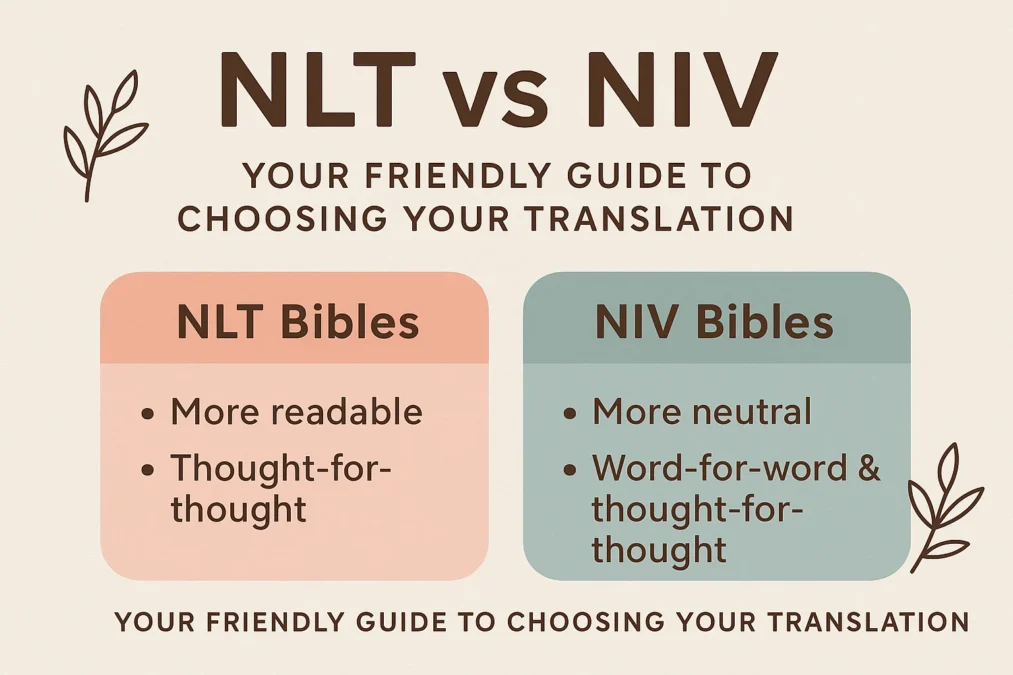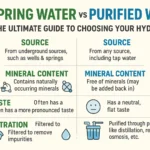Walking into a bookstore or browsing online for a new Bible can be an overwhelming experience. The shelves are lined with a dizzying array of translations, each with its own name, acronym, and promise of being the “best” or “most accurate.” Two of the most popular and frequently recommended versions are the New Living Translation (NLT) and the New International Version (NIV). If you’ve found yourself pondering the difference between the nlt vs niv bibles, you’re not alone. This isn’t a question of which one is objectively better, but rather which one is better for you, your reading style, and your spiritual journey.
Both the NIV and NLT have earned their spots as bestsellers for good reason. They both strive to make the ancient texts of the Bible accessible to modern readers, but they approach this goal from different translation philosophies. Understanding this core difference is the key to unlocking which translation will resonate with you most deeply. This comprehensive guide will dive into the history, philosophy, strengths, and ideal readers for both the NLT and NIV Bibles, providing you with all the information you need to make a confident and informed decision. We’ll move beyond the acronyms and explore the heart of these translations, helping you find the version that will draw you closer to the scripture.
Understanding Bible Translation Philosophies
Before we can effectively compare the nlt vs niv, we need to lay a foundation of what makes translations different. It all comes down to a spectrum, with “formal equivalence” on one end and “functional equivalence” on the other. Think of it like this: are you trying to translate the exact words, or are you trying to translate the thought and meaning behind those words? This is the central tension in Bible translation, and every version falls somewhere on this scale.
Formal equivalence, often called “word-for-word” translation, aims to stick as closely as possible to the original Hebrew, Aramaic, and Greek words and sentence structure. The priority is on preserving the literal phrasing of the original text, even if it results in a slightly more awkward or complex English sentence. This approach allows readers to get closer to the precise linguistic choices of the biblical authors. On the opposite end, functional equivalence (often called “thought-for-thought”) prioritizes conveying the meaning, intent, and impact of the original text in natural, everyday English. The translators ask, “How would we say this same idea today?” The goal is clarity and readability above literal precision.
Most modern translations, including both the NIV and NLT Bibles, don’t sit purely on one extreme end; they exist somewhere in the middle, leaning toward one philosophy. Where they fall on this spectrum is the most significant factor in the nlt vs niv bible discussion. It influences everything from the reading level to the interpretive choices made in tricky passages. Recognizing this spectrum empowers you as a reader to understand why two translations might phrase the same verse differently.
The New International Version (NIV): A Balanced Approach
The NIV is arguably one of the most influential and widely used Bible translations of the last 50 years. Its creation was a monumental effort starting in the 1960s, undertaken by a diverse team of international scholars from various Protestant denominations. Their goal was to create a translation that was both accurate and accessible, a Bible that could be used for everything from deep theological study to personal devotions and public reading in church services. This desire for a wide range of uses led the committee to adopt a “mediating” or “balanced” translation philosophy.
The NIV is famously described as a “thought-for-thought” translation, but in practice, it leans toward the center of the translation spectrum. It seeks to find a middle ground between the literal, word-for-word precision of translations like the ESV or NASB and the highly dynamic, meaning-driven approach of translations like the NLT. The NIV translators prioritized capturing the meaning of the original languages, but they did so while trying to retain a certain amount of the original text’s phrasing and structure. This makes the NIV a versatile workhorse—accurate enough for serious study while being clear and readable enough for a new believer or someone reading aloud to a congregation.
The result is a translation that feels dignified and reliable without being overly academic or difficult to understand. For many Christians, the NIV strikes the perfect balance, making it a default choice for a primary Bible. Its widespread adoption by churches, schools, and study Bible publishers is a testament to its success in achieving its goal. When comparing the nlt vs niv, the NIV often emerges as the choice for those who want a blend of scholarly credibility and everyday readability without venturing too far into paraphrase.
Strengths and Ideal Readers of the NIV Bible
The primary strength of the NIV is its remarkable balance. It manages to be a true all-purpose Bible. You can comfortably use an NIV for inductive Bible study, following along with a sermon, memorizing scripture, and reading to your children at night. Its language is modern and clear but avoids being overly casual or colloquial, maintaining a tone that feels appropriate for worship and reverence. This versatility is a huge reason for its enduring popularity and makes it an excellent choice for someone who wants just one Bible for all purposes.
The NIV is particularly well-suited for a specific type of reader. If you are someone who values accuracy and wants to feel confident that your translation is backed by rigorous scholarship, but you find strictly word-for-word translations to be clunky or hard to follow, the NIV is likely your sweet spot. It’s also an ideal first “adult” Bible for teenagers or new believers graduating from storybook Bibles, as it provides more depth without being intimidating. Furthermore, because it is so widely used, finding a NIV study Bible with extensive notes, cross-references, and applications is very easy, enhancing its value for personal growth.
The New Living Translation (NLT): Clarity and Readability
If the NIV seeks balance, the New Living Translation embraces a clear and distinct priority: utmost clarity and readability. The NLT has its roots in the Living Bible, a popular paraphrase created by Kenneth Taylor in the 1970s. While the Living Bible was a paraphrase of the English Bible (the American Standard Version), the NLT was a completely new translation begun in 1989, created by a team of 90 scholars working directly from the original languages. Their mandate was to create a translation that was exegetically accurate but rendered in dynamic, natural English.
The NLT firmly occupies the “thought-for-thought” end of the translation spectrum. Its philosophy is one of functional equivalence. The translators were less concerned with matching the exact vocabulary and grammar of the biblical authors and were laser-focused on answering the question, “What does this mean?” Their goal was to translate the message of the Bible into the kind of language we use every day when talking to a friend, writing an email, or telling a story. This makes the NLT an incredibly easy translation to read and understand, even for long stretches at a time.
For many readers, the NLT brings the Bible to life in a fresh and exciting way. Complex passages become clear, and the narrative sections of the Bible read with the flow and energy of a modern novel. The prophetic books, which can be dense and symbolic, become more accessible as the translators work to unpack the meaning behind the metaphors. This makes the nlt vs niv comparison a question of priority: do you want a balanced all-rounder (NIV) or a translation optimized for pure comprehension and narrative flow (NLT)?
Strengths and Ideal Readers of the NLT Bible
The greatest strength of the NLT is its unparalleled readability. It is designed to be understood on a first read-through, minimizing the need to stop and decipher archaic language or confusing sentence structures. This makes it an exceptional choice for devotional reading, for reading aloud in family settings, or for anyone for whom English is a second language. It’s also fantastic for new believers who might feel overwhelmed by more formal translations and need a clear, straightforward presentation of the biblical message.
The ideal reader for the NLT is someone whose main goal is to grasp the overall meaning and application of a passage quickly. It’s a favorite for those who like to read entire chapters or books of the Bible in one sitting, as the flowing prose makes extended reading a pleasure. Preachers and teachers sometimes use the NLT to provide a clear “sense of the text” before diving into a more detailed exegetical analysis with a more formal translation. If you find yourself getting bogged down in the “thees” and “thous” of older translations or even the slightly more formal tone of the NIV, the NLT might feel like a breath of fresh air.
A Head-to-Head Comparison: NLT vs NIV in Practice
The best way to understand the difference between the nlt and niv bibles is to see them side-by-side. Let’s look at a few key verses to observe how their translation philosophies play out in the text. These comparisons will highlight the NIV’s tendency toward balanced precision and the NLT’s drive toward dynamic clarity.
A classic example is Romans 12:1. The NIV reads: “Therefore, I urge you, brothers and sisters, in view of God’s mercy, to offer your bodies as a living sacrifice, holy and pleasing to God—this is your true and proper worship.” The NLT translates it as: “And so, dear brothers and sisters, I plead with you to give your bodies to God because of all he has done for you. Let them be a living and holy sacrifice—the kind he will find acceptable. This is truly the way to worship him.” Notice how the NIV is more concise (“offer your bodies”), while the NLT expands slightly for clarity (“give your bodies to God because of all he has done for you”) and breaks the single long sentence into two for easier digestion.
Another telling example is Proverbs 3:5-6. The NIV: “Trust in the Lord with all your heart and lean not on your own understanding; in all your ways submit to him, and he will make your paths straight.” The NLT: “Trust in the Lord with all your heart; do not depend on your own understanding. Seek his will in all you do, and he will show you which path to take.” The NIV’s “submit to him” is a direct rendering of the Hebrew, while the NLT’s “seek his will in all you do” explains what that submission looks like in practice. Similarly, “make your paths straight” is a common biblical metaphor that the NLT makes explicit with “show you which path to take.”
These comparisons aren’t about right or wrong; they’re about approach. The NIV retains more of the metaphorical language, trusting the reader to understand it. The NLT often makes the metaphor’s meaning explicit to ensure no reader misses the point. This is the essence of the nlt vs niv bible choice
Pentecostal vs Baptist: Understanding the Differences and Similarities.
A Comparison Table: NLT vs NIV at a Glance
| Feature | New International Version (NIV) | New Living Translation (NLT) |
|---|---|---|
| Translation Philosophy | Balanced (Mediating) | Dynamic Equivalence (Thought-for-Thought) |
| Reading Level | 7th-8th Grade | 6th Grade |
| Primary Strength | Versatility; balance of accuracy and readability | Exceptional clarity and ease of understanding |
| Tone | Dignified, modern, and reliable | Conversational, vivid, and narrative-driven |
| Ideal For | All-purpose use: study, teaching, devotion, liturgy | Devotional reading, new believers, children, ESL |
| Scholarly Endorsement | Very high; widely used in academic and church settings | High; a scholarly translation, but its method is questioned by some formalists |
Choosing the Right Bible for You: It’s About Context
So, after all this analysis, which wins in the debate between the nlt vs niv bibles? The answer is deeply personal and depends entirely on your intended use. Instead of looking for a single “winner,” a more helpful approach is to consider which translation is the right tool for the job you have in mind. Many dedicated Bible students and readers actually own and use both, appreciating the strengths each one brings to different situations.
If you are looking for a primary Bible that you can use for everything—from serious personal study to following along with a sermon to teaching a small group—the NIV is an outstanding choice. Its balanced approach means it rarely leads you astray, and its widespread use means you’ll have no trouble finding resources and study materials that match its text. It provides a reliable middle ground that satisfies the need for both intellectual integrity and practical understanding.
If your main priority is to read the Bible with ease, to get swept up in the story, or to have the meaning presented as clearly and unambiguously as possible, the NLT is a magnificent option. It is particularly powerful for devotional reading, where the goal is connection and application over technical analysis. It’s also an incredible gift for a young person, a new Christian, or anyone who has previously found the Bible confusing or difficult to engage with.
For the deepest study, many people employ a strategy of using multiple translations. You might read a passage in the NLT to get a clear, big-picture understanding of the meaning and flow. Then, you could switch to the NIV to get a slightly more precise look at the structure and wording of the original text. For very difficult passages, you might even consult a more formal translation like the ESV or NASB. This multi-translation approach allows you to benefit from the strengths of each philosophy and guards against misinterpreting a single translation’s particular rendering.
The Role of Personal Preference in Bible Reading
At the end of the day, the best Bible translation is the one that you will actually read, enjoy, and understand. All the scholarly endorsement in the world means little if a translation feels dry, foreign, or confusing to you. The Word of God is living and active, and its power is not locked into a single English version. The Holy Spirit can speak through both the precise balance of the NIV and the vibrant clarity of the NLT.
Don’t be afraid to listen to your own reading experience. Go to a bookstore or browse online samples. Read a familiar passage, like Psalm 23 or 1 Corinthians 13, in both the NLT and NIV Bibles. Which one resonates with you more? Which one paints a clearer picture in your mind? Which one feels more like a book you want to keep reading? Your intuitive reaction is an important data point.
Your stage of life and faith journey also matter. The translation that was perfect for you in seminary might not be the one you want to read to your kids at bedtime. The Bible you give to a skeptical friend might be different from the one you use for your own deep dives into theology. The discussion of nlt vs niv isn’t about finding a permanent champion for your bookshelf, but rather about understanding the tools available to you so you can choose the right one for every season and purpose of your life.
Conclusion
The journey through the world of Bible translations, specifically the nlt vs niv bibles, reveals a landscape rich with options designed to meet different needs. The New International Version (NIV) stands as a trusted, balanced, and versatile translation, perfect for the believer who wants a reliable all-in-one Bible for study, worship, and teaching. Its mediating philosophy offers a blend of accuracy and accessibility that has served the global church faithfully for decades. Conversely, the New Living Translation (NLT) shines as a beacon of clarity and readability, masterfully converting the ancient biblical message into the vibrant, everyday language of the 21st century. It is an ideal choice for devotional reading, for new believers, and for anyone who prioritizes immediate comprehension.
Ultimately, the choice between the NIV and NLT is not a theological test but a practical decision based on your personal reading preferences and goals. There is no loser in this comparison, only two excellent tools for different tasks. Whether you choose the balanced approach of the NIV or the dynamic clarity of the NLT, the most important step is to engage deeply and consistently with the life-changing words of Scripture. By understanding the strengths of each translation, you can confidently select the version that will best help you hear God’s voice and understand His message of love and grace.
Frequently Asked Questions (FAQ)
What is the main difference between the NLT and NIV translations?
The main difference lies in their translation philosophy. The NIV uses a balanced or “mediating” approach, striving for a middle ground between literal word-for-word and dynamic thought-for-thought translation. The NLT uses a dynamic equivalence or “thought-for-thought” philosophy, prioritizing clarity and natural English over literal precision. This makes the NLT generally easier to read, while the NIV is often seen as slightly more formal and precise.
Is the NLT or NIV more accurate?
Both translations are highly accurate and were created by teams of respected biblical scholars working directly from the original Hebrew, Aramaic, and Greek texts. “Accuracy” depends on what you mean. The NIV aims for accuracy in representing the original words and structures more directly. The NLT aims for accuracy in representing the original meaning and message in clear, modern English. Both are trustworthy, but they define “accuracy” through different lenses.
Which Bible is easier to read, the NLT or NIV?
The NLT is consistently ranked as one of the easiest-to-read modern English translations, often at a 6th-grade reading level. The NIV is also very readable but is generally considered to be at a 7th to 8th-grade reading level, making it slightly more complex. For pure ease of reading and comprehension, especially for new readers or children, the NLT often has the advantage.
Can I use the NLT for serious Bible study?
Yes, you can. The NLT is a legitimate translation from the original languages, not a paraphrase. Many people find it extremely helpful for study because its clarity helps them quickly understand the overall meaning of a passage. For deep word studies or exegetical analysis, it is often beneficial to compare the NLT with a more formal translation like the NIV, ESV, or NASB to get a fuller picture.
Why do most churches use the NIV instead of the NLT?
The NIV’s balanced philosophy makes it a very safe and versatile choice for corporate worship. It is formal enough to feel dignified and reverent during a church service yet clear enough for public reading and for a congregation to understand. Its widespread adoption over many decades has also made it a standard, meaning church resources, curricula, and memorization plans are often built around it. The NLT’s more conversational tone is sometimes perceived as too casual for liturgical use by some congregations, though this is changing.



